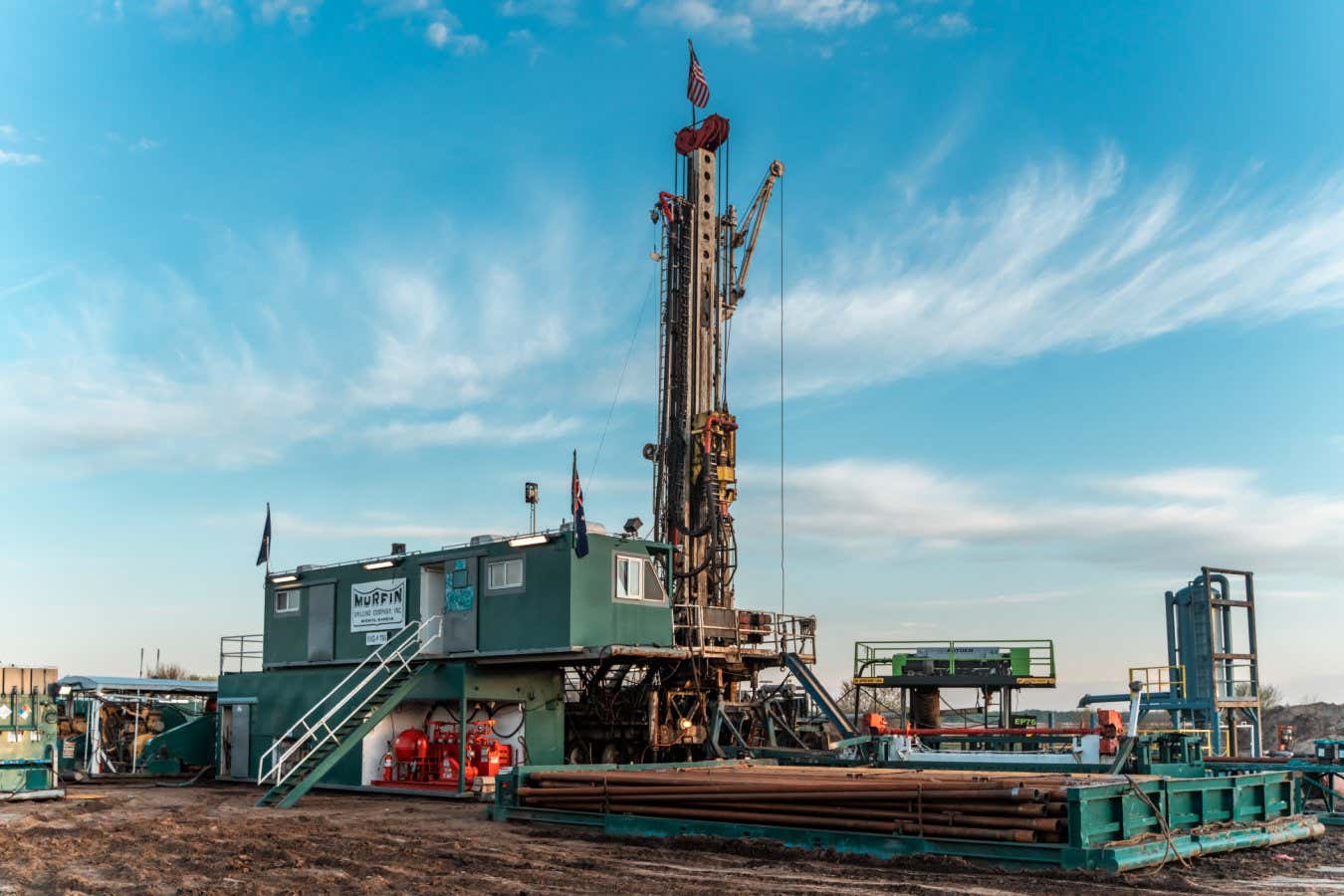
New Scientist visited a hydrogen well in Kansas
Hyterra/Adler Grey
The drilling rig rises several stories above a field normally full of grazing cattle. Though we’re in Kansas, the rig is flying both an American and an Australian flag to reflect its owner’s origin down under: HyTerra has come all the way from Australia in search of natural hydrogen fuel produced deep within an ancient fracture in North America.
“Behind us is the Midcontinent rift, which we think is the kitchen where the hydrogen gets made,” says Avon McIntyre, the company’s executive director. The rift has drawn many companies to the US Midwest, making eastern Kansas one of the busiest frontiers in a worldwide search for “geologic hydrogen”, which many hope could serve as a zero-carbon alternative to fossil fuels.
The story starts around 1.3 billion years ago, when the continental plate that is now North America began to split in two. Although the continent eventually stopped spreading, the fracture left behind a 2000-kilometre-long scar of iron-rich mantle rock. Today, this rift is buried deep beneath the farms and ranches of the US Midwest.
In eastern Kansas, where the solid rock around the rift rises relatively near the surface, high concentrations of hydrogen have been measured in old oil and gas wells. To see if it can be harvested, a handful of companies have leased hydrogen drilling rights on more than 100,000 hectares of land in the area. That’s according to McIntyre’s estimates, which are based on public courthouse filings. HyTerra and its competitor Koloma have gone further, beginning to actually drill deep underground.
“It is kind of like the gold rush, where everybody is trying to find it,” says Kristen Delano at Colorado-based Koloma. She would not say where the company is drilling in Kansas, but says it is public knowledge they have drilled there. Other companies, such as another Australian firm called Top End Energy, have been buying up mineral rights based solely on where Koloma is thought to be buying.
“There’s been a lot of buzz around the community,” says Shawn McIntyre, who has no relation to HyTerra’s executive director. Shawn is a rancher in Waterville, Kansas who has leased several thousand acres of his land for hydrogen drilling. “This could be a very good opportunity to bring industry back to some of the smaller towns that are drying up in this part of the world.”
The global hunt for underground hydrogen was spurred just a few years ago by revised estimates of how much the planet might contain. Companies searching for accumulations of the gas hope it could serve as a low-emissions alternative to the fossil fuels now used to make fertiliser and power heavy industry and transportation. “Natural hydrogen just fits perfectly into that picture,” says Jay Kalbas at the Kansas Geological Survey. “If we… are sitting on vast quantities of producible hydrogen, that could change not only the state and the region, but the country.”
At the drilling site south-west of Manhattan, Kansas, Avon McIntyre and I tramp through the mud and climb up onto the drilling platform. “It’s all to find out what the hell is going on down there,” McIntyre shouts over the roar of the rig.
The company’s working theory is that hydrogen is generated when water from underground aquifers seeps into the iron-rich mantle rock of the Midcontinent rift and reacts with the metal in a process called serpentinisation. This reaction frees up the water’s hydrogen molecules, which migrate into the surrounding rock.
This is the second of five exploratory wells HyTerra plans to drill in Kansas this year, intended to detect hydrogen along a line stretching eastwards from the rift itself to an underground rise in the bedrock called the Nemaha ridge. Earlier this year, the company reported that its first well, drilled into the high point of the ridge, detected hydrogen concentrations of 96 per cent.
Now, after weeks of drilling for 24 hours a day, the second well was nearing its maximum depth, just beyond 1600 metres. Atop the rig, mud filled with cuttings from the granite far below burbled out of the hole into a trough, where tubes sucked gas out of the liquid for measurement.
In the “mud shack”, a small mobile office at the edge of the site, a group of contractors watched on a bank of screens as instruments reported the composition of the gas from different depths in real time. After staying at low levels through much of the solid rock, the hydrogen concentration had just started to tick up to more than 800 parts per million.
“[The first well] had some really nice peaks, but this one is just bleeding hydrogen,” says HyTerra’s Josh Whitcombe.
These measurements mean little on their own. Gas samples have to be sent off site for more controlled testing. Further, high concentrations of hydrogen don’t indicate anything about how much gas might actually flow from the well and for how long.
Even if hydrogen eventually flows from any of these wells, numerous other questions remain, including how it would be separated from other gases, how it would be stored and transported and who would buy it.
But McIntyre was excited that they had detected hydrogen that far down at all, and he pushed for the crew to continue drilling through the night. “We’re drilling for information,” he says. “And now we’ve got some.”
Topics:
Source link : https://www.newscientist.com/article/2483996-the-prospectors-hunting-hydrogen-along-a-us-continental-rift/?utm_campaign=RSS%7CNSNS&utm_source=NSNS&utm_medium=RSS&utm_content=home
Author :
Publish date : 2025-06-16 21:00:00
Copyright for syndicated content belongs to the linked Source.